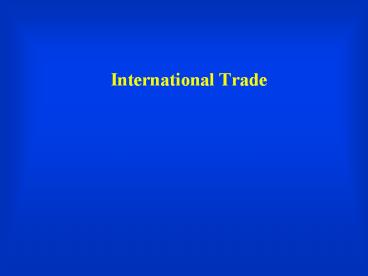International Trade - PowerPoint PPT Presentation
1 / 20
Title:
International Trade
Description:
Exam: Concepts from Student Presentation Security Council Reform Why is SC reform on the UN agenda? Which four countries are considered for permanent membership? – PowerPoint PPT presentation
Number of Views:24
Avg rating:3.0/5.0
Title: International Trade
1
International Trade
2
Exam Concepts from Student Presentation
- Security Council Reform
- Why is SC reform on the UN agenda?
- Which four countries are considered for permanent
membership? - CEDAW Convention Is the US a signatory? Why?
Role in Womens Rights Issues - ICC When was it established?
- What kind of crimes does it prosecute?
- Is the US a party and why? Are EU countries
parties? - Similarities and differences with tribunals
(Yugoslavia, Rwanda) - Terrorism policy options for dealing with
international terrorism pros and cons of each
3
Political Economy
- Studies the relationship between economics and
politics (Gilpin 1975) - Politics shape the framework of economic
transactions - Economic activities generate and redistributes
wealth - Reshapes power and politics among groups
4
Logic of Economic Liberalism
- Adams Smith (1723-1790) and David Ricardo
(1772-1823) - Gains from trade
- Comparative advantage
- Specialization and economies of scale
- Trade consume more at a lower price
- Gains from trade common but asymmetrical
5
Historical Alternatives
- Mercantilism
- Trade serves political purposes
- Accumulate surplus and money
- Augment military power
- Marxism
- Capital gains from markets and trade while labor
is exploited - Market driven imperialism
- Dependency of the South to the North
6
- Levels Trade Openness
7
Autarky
- Albania 1970s, 1980s
- Communist country
- Broke rang with the USSR and the Council for
Mutual Economic Assistance (CMEA) - Strategy of self reliance
- Largely closed to trade
- Outcomes technological backwardness, poverty,
inefficiency, weakened power
8
Protectionism
- Protect certain domestic industries from foreign
competition - Objectives
- Self-sufficiency and security (agriculture,
military equipment) - Protect infant industry
- Predictability, less dependency, social stability
- Satisfy political lobbies
- Respond to predatory dumping on the part of
trading partners - Generate direct government revenue (if tariffs
used)
9
Protectionist Instruments
- Quotas
- Quotas on textile imports
- Multifibre Arrangement (1974)
- Tariffs
- US tariffs over 9 canned tuna, frozen orange
juice, rubber footwear, non-athletic women's
footwear, ceramic tiles, etc. - Subsidies
- U.S. government support for sugar cane, cotton,
corn subsidies - Korean steel and electronics 1980s
- Other non-tariff barriers
- EU ban on hormone-treated beef, US ban on Mexican
tuna, Canada requirement of reusable beer
containers
10
Liberal Trade Policies
- Reduce tariffs
- Eliminate/reduce non-tariff barriers
- Washington Consensus
11
- Conditions for an Open World Order
12
Hegemonic Stability Theory
- Interests and power shape trading regimes
- Hegemonic states as guarantors of free trade
- Gain most
- Less vulnerable to social disruption
- Less vulnerable to cheating
- Power to persuade others to join
- Examples?
13
Liberal Institutionalism
- Robert Keohane After Hegemony (1986)
- Even hegemonic states need institutions to
achieve reciprocity and reduce transaction costs - Institutions are sticky persist even after
decline of hegemon, or despite short-term
interest of the hegemon - Examples?
14
US Steel Tariffs
- US imposes 30 steel tariffs in 2002
- EU challenged the US in the WTO
- WTO rules against steel tariffs in 2003
- President Bush removed the tariffs in 2004.
- Why?
15
Liberalism and Domestic Politics
- Trade redistributes wealth
- Creates losers and winners
- Consumers win
- Import-competing sectors loose export sectors
win - Does labor loose or win?
- Who looses and who wins from higher steel
tariffs?
16
Trade Institutions
- The GATT (General Agreement on Tariffs and
Trade), 1947 - Facilitate negotiations to reduce tariffs and
NTBs - Average tariffs dropped from 40 of the goods
value in 1945 to 3 of the goods value in 2002 - Rounds of negotiations
- -The Kennedy round (1960s)
- -Doha Round (2001) under the WTO
- Dispute resolution mechanism
17
Trade Institutions
- The WTO (World Trade Organization), 1995
- Replaced GATT
- International organization with a staff of
approximately 500 - Expanded menu of cooperation
- Trade in services, intellectual property rights
- Adjudicates disputes
- Trade and environment, labor rights, human rights
18
WTO Current Issues
19
Current Issues Agricultural Trade
- Developing countries comparative advantage in
agricultural products - Industrial countries heavy agricultural
subsidies - The Doha (2001) round and the road ahead?
- Negotiations broke down in Cancun
- EU faces pressures for internal reform of the
Common Agricultural Policies - But liberalization opposed by strong domestic
lobbies in industrial countries - What to do?
20
Intellectual Property Rights
- Piracy of software, music, films
- WTO International Treaty on Trade Related
Intellectual Property Rights (TRIPS) (1994) - Issues of domestic enforcement
- Patents on drugs and biotechnology contentious
- HIV/AID drugs































